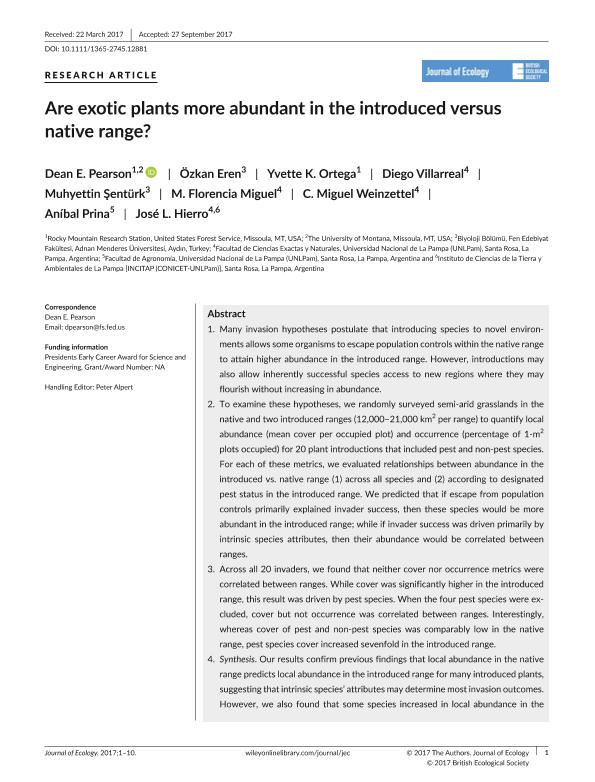Artículo
Are exotic plants more abundant in the introduced versus native range?
Pearson, Dean; Eren, Ozkan; Ortega, Yvette K.; Villarreal, Diego; Sentürk, Muhyettin; Miguel, María Florencia ; Weinzettel, Cristian Miguel; Prina, Anibal Oscar; Hierro, Jose Luis
; Weinzettel, Cristian Miguel; Prina, Anibal Oscar; Hierro, Jose Luis
 ; Weinzettel, Cristian Miguel; Prina, Anibal Oscar; Hierro, Jose Luis
; Weinzettel, Cristian Miguel; Prina, Anibal Oscar; Hierro, Jose Luis
Fecha de publicación:
12/2017
Editorial:
Wiley Blackwell Publishing, Inc
Revista:
Journal of Ecology
ISSN:
0022-0477
Idioma:
Inglés
Tipo de recurso:
Artículo publicado
Clasificación temática:
Resumen
Many invasion hypotheses postulate that introducing species to novel environments allows some organisms to escape population controls within the native range to attain higher abundance in the introduced range. However, introductions may also allow inherently successful species access to new regions where they may flourish without increasing in abundance.
To examine these hypotheses, we randomly surveyed semi‐arid grasslands in the native and two introduced ranges (12,000–21,000 km2 per range) to quantify local abundance (mean cover per occupied plot) and occurrence (percentage of 1‐m2 plots occupied) for 20 plant introductions that included pest and non‐pest species. For each of these metrics, we evaluated relationships between abundance in the introduced vs. native range (1) across all species and (2) according to designated pest status in the introduced range. We predicted that if escape from population controls primarily explained invader success, then these species would be more abundant in the introduced range; while if invader success was driven primarily by intrinsic species attributes, then their abundance would be correlated between ranges.
Across all 20 invaders, we found that neither cover nor occurrence metrics were correlated between ranges. While cover was significantly higher in the introduced range, this result was driven by pest species. When the four pest species were excluded, cover but not occurrence was correlated between ranges. Interestingly, whereas cover of pest and non‐pest species was comparably low in the native range, pest species cover increased sevenfold in the introduced range.
Synthesis. Our results confirm previous findings that local abundance in the native range predicts local abundance in the introduced range for many introduced plants, suggesting that intrinsic species’ attributes may determine most invasion outcomes. However, we also found that some species increased in local abundance in the introduced range, suggesting that changes in biogeographic context may also play an important role. While these latter species were pests, the small sample size precluded strong inferences. Determining what underlies the success of invasive pests remains elusive due to their low representation among introduced species.
Palabras clave:
Biogeography
,
Invasion
,
Local Abundance
,
Occurrence
Archivos asociados
Licencia
Identificadores
Colecciones
Articulos(INCITAP)
Articulos de INST.D/CS D/L/TIERRA Y AMBIENTALES D/L/PAMPA
Articulos de INST.D/CS D/L/TIERRA Y AMBIENTALES D/L/PAMPA
Citación
Pearson, Dean; Eren, Ozkan; Ortega, Yvette K.; Villarreal, Diego; Sentürk, Muhyettin; et al.; Are exotic plants more abundant in the introduced versus native range?; Wiley Blackwell Publishing, Inc; Journal of Ecology; 106; 2; 12-2017; 1-10
Compartir
Altmétricas



